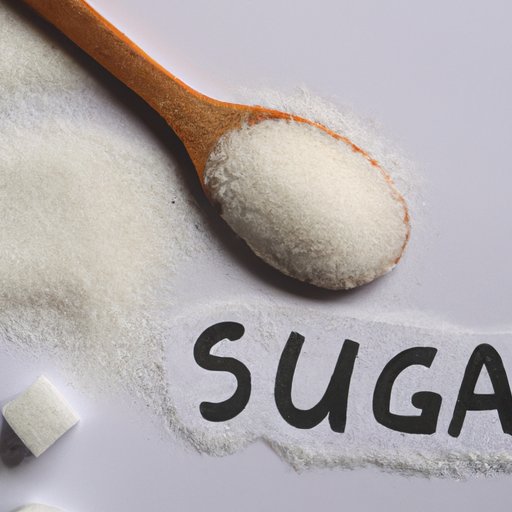
How to Eliminate Sugar from Your Diet
Sugar has long been a staple of the American diet, and the prevalence of sugar in our food is ever-increasing. While many of us enjoy sweet treats and sugary snacks, data suggests that consuming too much sugar can be detrimental to our health. As such, the time has come to take a closer look at sugar and take steps to reduce our intake. In this article, we will explore the reasons why eliminating sugar from your diet is so important, provide strategies for gradually decreasing sugar intake, and offer tips for alternatives to satisfy your sweet tooth.
Start with Why
The first step in reducing sugar intake is understanding why it is important to do so. To put it simply: sugar is bad for your health. Studies suggest that consuming too much sugar can lead to obesity, metabolic syndrome, diabetes, and heart disease.
While many are aware of the harmful consequences of consuming too much sugar, few understand the extent to which sugar is hidden in processed foods. Even foods that are marketed as healthy options may contain high amounts of sugar. For example, canned fruits, juices, and sports drinks are all common sources of sugar. Natural sweeteners like honey, stevia, and maple syrup can be healthy alternatives to sugar. But it is important to do your research to ensure that you are fully aware of the sugar content in the foods you consume.
Understand Hidden Sugar
To better understand sugar’s role in our diet, it is important to know where it hides. While many of us think of sugar as an additive that is found in sugary snacks and desserts, it is often hidden in many processed foods.
Natural alternatives to sugar do exist. Honey, maple syrup, and stevia are all wonderful, natural sweeteners that can be used to replace sugar in recipes. However, it is important to be aware of hidden sugars in processed foods. To make an informed decision about what is best for your health, it is important to know how to read labels and accurately identify different types of sugar.
Read the Labels
When it comes to reducing sugar intake, reading labels is key. The problem is, sugar is often hidden by different names – corn syrup, dextrose, cane sugar – making it difficult for consumers to identify sugar in food products. Learning to read labels and identify different types of sugar is key in making an informed decision about what is best for your health.
While some types of sugar are more problematic than others, it is important to note that all sugar converted in the body to glucose, a type of sugar that can be used for energy. High levels of glucose in the bloodstream can lead to a host of medical conditions. This is why it is important to reduce intake of all types of sugar.
Gradually Decrease Sugar Intake
The best way to start eliminating sugar from your diet is by beginning with small changes. You can start by cooking your meals at home and reducing the amount of added sugar in the recipes. Instead of using artificial sweeteners, try using low-glycemic index foods. While some types of sugar are considered “bad” for our bodies, others (like those found in fruits and honey) can provide nutritional value. These are considered “good” sugars and can be incorporated into your diet safely in moderation.
Identify Triggers
Another important step in eliminating sugar from your diet is to identify your sugar triggers – the situations or foods that cause cravings for sugar. For many, emotional eating is a trigger. Instead of reaching for sugary snacks when you feel stressed or anxious, find other activities to help you manage your emotions and reduce your stress levels. For example, taking a walk, practicing yoga, or deep breathing can all be effective ways to manage emotional eating.
Focus on Complex Carbs
Carbs are often thought of as foods to be avoided. Yet, while simple carbs (like sugar and processed white bread) can be problematic, there is a broad spectrum of carbs. Complex carbohydrates are full of fiber and much healthier for the body. They provide a slow release of energy and can help manage blood sugar levels by preventing spikes in glucose levels. Some examples of foods high in complex carbs include lentils, brown rice, quinoa, and sweet potatoes. By incorporating complex carbs into your diet, you can help to curb your sugar cravings and feel more satisfied in-between meals.
Provide Alternatives
Now that you understand why reducing your intake of sugar is effective at managing your health, you are likely curious about healthy alternatives to sugar. There are many natural sweeteners that can be used in place of sugar. Honey, for example, not only has antibacterial properties but also acts as a natural cough suppressant and is also full of antioxidants. Stevia is a natural sweetener derived from a plant that is sweeter than sugar and is a great option for people with diabetes. Finally, spices like cinnamon and vanilla extract can add taste to foods without adding sugar.
Conclusion
To make a significant impact on your health, reducing the amount of sugar in your diet is key. However, it is important to understand that it is not a quick fix. The best way to reduce sugar intake is to be gradual, ditch artificial sweeteners in favor of natural sweeteners, and focus on eating a range of healthy foods full of nutrients. By incorporating these simple steps into your diet, you can effectively reduce your sugar intake, improve your overall health, and feel great.





